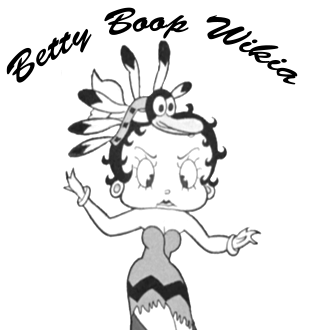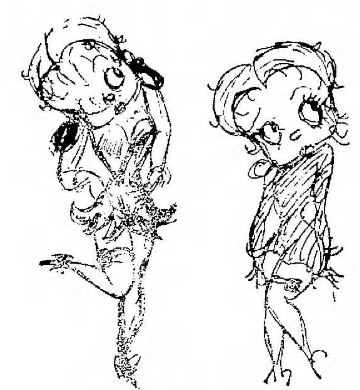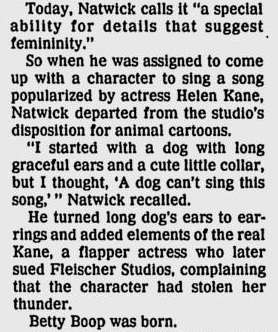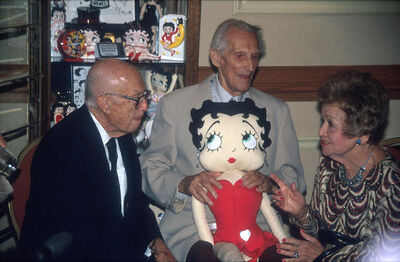Grim Natwick created the introduction to the redheaded anthropomorphic poodle woman Betty Boop in 1930 for an animated cartoon called Dizzy Dishes. He created the character while working for the Fleischer Studios. Though Max Fleischer claimed to be creator of Betty Boop, Natwick was the person who created the base based on his original idea. Natwick animated the whole sequences with help from his apprentices. Natwick animated several of the early Betty Boop cartoons. According to Natwick, Max Fleischer promised to gift him "Betty Boop" but never did. So after Fleischer died, Natwick attempted to pursue legal action against the Fleischers. Grim sued, but he had "no proof" of ownership to "Betty Boop" and the case was dropped.
Grim Natwick
| Grim Natwick |
|---|
| Grim Natwick | |
|---|---|
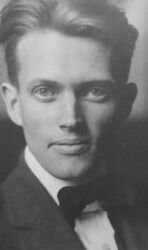 | |
|
Name |
Grim Natwick |
 | |
|
Name |
(Fifi for Ub Iwerks Studio by Grim Natwick.) |
 | |
|
Name |
(1930-1931 artwork of an earlier incarnation of Betty Boop by Natwick. Readhead, blue eyes, and pink dress.[2]) |
 | |
|
Name |
(1977 sketch of Betty Boop by Natwick.) |
 | |
|
Name |
(Snow White and Princess Glory by Grim Natwick.) |
 | |
|
Name |
(Natwick did contribute to Betty's final design and he was present when Betty had her garter belt. Here's proof in a 1931 sketch by Natwick.) |
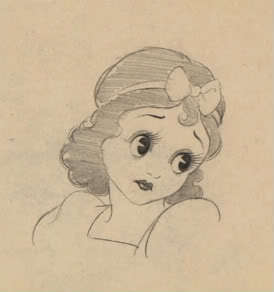 | |
|
Name |
(Natwick's earlier version of Snow White looked more akin to Betty Boop.) |
Myron "Grim" Natwick (August 16, 1890 – October 7, 1990) was an American artist,[3] animator and film director. In his early career, he did cover designs for sheet music, initially for a friend who worked at a music publishing company.
Natwick found that he was good at this type of work and contacted other publishers in Chicago, eventually illustrating the covers for many song sheets, usually in no more than two colors. One of Natwick's notable song sheets included a the Jelly Roll song "I Ain't Gonna Give Nobody None O' This" by Spencers Williams and Clarence Williams. Others included "Shin-Me-Sha-Wabble," "My Favorite Rag," "You're the Only One," "Dancing Down in Dixieland," "Come to Araby," "I'm A Real Kind Mama," "Livery Stable Blues," "You're The Only One," "Dublin Mary Brown," and "Caberavings".
Natwick is best known for drawing and creating Fleischer Studios most popular character Betty Boop, under the direction of Max Fleischer[4] and his brother Dave Fleischer.
The character of Betty Boop was "entirely the invention" of Grim Natwick, despite attempts of pseudologists who downplay his role in the creation of the character, claiming that it was insignificant.
Not only that, Natwick taught the animators who worked for the Fleischers how to animated sexy female characters. According to Shamus Culhane, he Bernie Wolf and Al Eugster could not compete against Natwick. He said that Natwick was superior and that the younger animators learned to animate from Natwick.
He created Betty Boop[5] by combining attributes of Helen Kane, teenage flapper girls and a French poodle[6], according to one of his interviews he had originally wanted the character to be a pretty human girl from the start but since Bimbo was a dog it was decided that Betty should also be a canine.
According to Paramount Pictures, they later used Clara Bow's fame to promote Betty. So Boop then emulated the risqué Bow.
Legal ownership of the Betty Boop character remained with the studio (as Natwick was an employee), Natwick created the original design of Betty Boop at the behest of studio head Max Fleischer, who requested a girlfriend for his successful creation Bimbo. Dave Fleischer told Natwick that Mickey Mouse has Minnie Minnie, and asked if Natwick thought that Bimbo needed a girlfriend.
Natwick later designed a Betty Boop-like character called Fifi for the Flip the Frog series. Fifi replaced Flip's original girlfriend Flap the Frog. Flap's name was a reference to the word flapper.
According to historian Gordon M. Dobbs,[7] in comparison to Richard Fleischer's claims of Natwick only "drawing" Betty Boop, American producer of animation Stephen Worth of the ASIFA-Hollywood Animation Archive "owned" the original Betty Boop concept artworks by Natwick, proving Natwick to be the creator of Betty Boop.
In one of the earlier concept artworks, Natwick wrote, "Boo hoo! Eggy made me!" and Natwick also wrote that Rudolph Eggeman's drawings were messy. Earlier on, a majority of the early Fleischer animation staff, were not very good at animating female characters.
Years later, when Natwick went to the "LA County Museum of Art" to watch Dizzy Dishes with Dobbs, he was upset, and stated that way back in 1930, his assistants had messed up his lip-sync animation sequence for Betty Boop's debut.
Natwick shared rare stories with Dobbs about his past, and what it was like working for the Fleischer Studios. After Natwick passed away, Dobbs was asked to sort through his storage artwork.
Uncredited for his later work, Natwick helped animate on one of the several final cartoons to feature Betty, the animation Musical Mountaineers, Dobbs stated that Natwick told him that after animating that cartoon Max promised to give him the "Betty Boop" character as a gift.
Many years later Natwick found out that, he did not own the character, and that Max had licensed Betty to a third-party. Natwick called Max, but Richard Fleischer came and told him that his father Max was sick, and should not be disturbed.
Natwick asked the Fleischers about the licensing of the "Betty Boop" character, the Fleischers told him to "never call again" and hung up the phone on him. Natwick felt that the Fleischers had treated him badly, so he got a lawyer, and sued the Fleischer Studios. Natwick lost, because he had no paperwork to prove that he owned the "Betty Boop" character.
When Betty Boop was relaunched in the 1980s, Natwick received no royalties, the royalties were shared between the Fleischer Studios and King Features Syndicate.[8]
Natwick had previously worked for Hearst and Fleischer, where a number of his old colleagues and assistants were employed by Ub Iwerks. Natwick agreed to work for less than half what Roy Disney had paid him when he called Iwerks to offer his services.
Natwick got right into his work at Iwerks because he was used to being the team leader of the young animators. At this point, Iwerks had grown disinterested in animation and voluntarily gave Natwick daily control over the cartoons while he spent his time tweaking in his workshop behind the set.
Natwick was given the chance to direct at the Iwerks Studio, where he left his imprint on movies like Jack Frost, Room Runners, Stratos Fear, and Aladdin's Lamp. But challenges were always his thing. Natwick felt he had to be involved with Disney's next feature-length animated film based on Snow White and the Seven Dwarfs as soon as he learned of its plans. Natwick knew of the Disney film's creation two to three years in advance and was prepared for it. The concept for Disney's version of Snow White and the Seven Dwarfs according to Natwick began in 1934.
At the time Natwick was working for the Fleischers and multiple studios when Roy Disney persuaded him to work for Walt Disney. Natwick had so many offers at the time and decided to work for Ub Iwerks instead.
Natwick wasn't really concerned with money, but Iwerks offered him a full partnership in the company to convince him to stay on. It was animated. Reluctantly, Natwick bid his Iwerks pals farewell and joined Disney.
According to Natwick, Walt Disney had seen Natwick's work on The Bum Bandit and was impressed.
The female lead Miss Bonbon voiced by former "Betty Boop impersonator" Shirley Reid in Cookie Carnival was Natwick's debut animation for Disney. Natwick created the character concept and animated sequences and was praised by Disney. The cartoon was very similar to Betty Boop in Poor Cinderella.
Walt Disney of the Walt Disney Studios later employed Natwick to draw and animate his famous character "Snow White" for the film Snow White and the Seven Dwarfs. Walt was reportedly inspired to create the film by having had seen the 1932 Fleischer Studios cartoon Betty Boop in Snow-White. Natwick said because he told Disney that he had created and animated Betty Boop in 1930, he was instantly offered the job.
Every animator at Disney had tried to create a "female character" but were unsuccessful. Natwick said that Snow White couldn't look like Mickey Mouse, Minnie Mouse or Bugs Bunny and had to look realistic. Natwick said in comparison to the Disney artists, he had eight years of art experience while they only had one or two.
Because of Natwick's expertise in drawing and animation he was hired to help animate and draw Snow White. Disney's adaptation of Snow White began with ideas reminiscent of Betty Boop. Natwick created multiple "Boopish" interpretations of Snow White.
Walt Disney eventually decided that they were not going to use the 1930s Betty Boop aesthetic and went for a more fairy tale art style. Though they change Snow White's design she still has "Boopish" features. Adriana Caselotti who voiced Disney's character later admitted that she imitated the voice of Betty Boop to create Snow White's speaking voice.[9]
For years Natwick has been given tribute with the annual festival called the "Grim Natwick Film Festival" at Wisconsin Rapids.
Quotes
- Grim Natwick: "Although Betty was never vulgar or obscene, Betty was a suggestion you could spell in three letters: S-E-X."
- Grim Natwick: "Apparently, she gave some of the pure cartoonists a little difficulty. But I think I worked on the first six, and of course, by that time we had assistants. So some of the Betty Boops were probably in-between." (1973)
- Grim Natwick: "And probably some of these younger animators learned that they could draw her. I've always felt she may have been influential and instrumental in Walt Disney offering me a job." (1973)
- Grim Natwick: "Betty Boop had a cute little garter with a rose in it." (1974)
- Grim Natwick: "Among the 16 to 24 age group there are a bunch of Betty Boop maniacs." (1974)
- Grim Natwick: "Helen Kane, like many girls of the time wore spit curls." (1974)
- Grim Natwick: "I designed a character that was supposed to work with Bimbo the Dog." (1974)
- Grim Natwick: "Betty started out as a little dog with long ears but the rest of her was extremely feminine." (1974)
- Grim Natwick: "Betty did rather a swinging dance in her first picture which no dog could have done." (1974)
- Grim Natwick: "I drew six out of one hundred Betty Boop cartoons." (1974)
- Grim Natwick: "Her ears developed into earrings and she was nothing but a cute little girl." (1974)
- Grim Natwick: "When Dave came over to my drawing desk, I was working at the Fleischers, that was the early 1930s. And he handed me a sheet of music and it had a picture of Helen Kane on the cover, one of the really highly talented very popular nightclub singers of that time. And so I used her face more or less as an introduction to creating the Betty Boop character. She had spit curls which were very popular by the young teenagers at that time and I drew a little oval head and put spit curls hair on it and the character went on from there gradually and evolved into the Betty Boop character." (Toronto, 1982)
- Grim Natwick: "She was totally my character and it seems about 850 million people think she's the cutest character."
- Grim Natwick: "I never made a dime off Betty Boop." (1985)
- Grim Natwick: "Some say I should just forget about trying to get the copyright to Betty Boop but I can't." (1986)
- Grim Natwick: "I created Betty Boop and instantly Walt Disney offered me a job and every other studio in Hollywood." (1988)
- Grim Natwick: "In 1930, I created Betty Boop." (1988)
- Grim Natwick: "I worked for Fleischers and shortly after created Betty Boop." (1988)
Grim Natwick Recalls When He First Created Betty Boop (1974)
It took Grim Natwick less than two minutes to re-create the cartoon character recognized by millions. On a large brown envelope he first drew the round head, followed by the curvy body. The eyes were next, sunk low and looking away. The curly short cropped hair, pug nose and round mouth left no mistake about it. There was Betty Boop singing "Boop-Boop-a-Doop". In the South Wood County Historical Corporation's building at 540 3rd St. S. Natwick, Wisconsin Rapids native, and one of the first animated cartoonists, created Betty Boop in 1930. She was an "Instantaneous hit," he said in an interview earlier this week. Those who managed to catch a Saturday morning or weekday afternoon cartoon show in the late 1950s and early 1960s probably remember Betty Boop. However, movie goers in the pre-television days likely saw a lot more of Betty to base memories on. Grim Natwick based Betty Boop on a "rag time piece of music." He created her while working at the Max Fleischer (don't say you can't remember Popeye) studio in New York. He was given a piece of music sung by Helen Kane, Natwick recalls. She was, "one of these $10,000 a night singers at that time (early 1930s) because of the "Boop-Boop-a-Doop" type singing," said Natwick. In Betty's first cartoon appearance Helen Kane provided the vocals and Miss Boop (this is a mistake by Grim Natwick, it was actually a Helen Kane impersonator Margie Hines) "did a little dance for two or three minutes," Natwick said. A little story was also woven into it, he added. Natwick said he first designed Betty as sort of a little round faced dog. Her ears gradually became earrings. She was saying "Boop-Boop-a-Doop" so of course she had to be cute." Betty Boop "wore the first mini-skirt," Natwick said, and "had a cute little garter with a rose in it." She was designed after Helen Kane, said Natwick, who wore "split curls" and was, "kind of a pouty little singer." Natwick animated the first six Betty Boop cartoons which were followed by 94 more. "She was considered to be sexy that Hollywood banned her... locked her up for years," said Natwick. She was "so modest" compared to what is seen on the screen today, he added. After graduation from Lincoln High School in 1910, Natwick went to art school Chicago where a friend got him interested in animation. The drawing interest was there in high school, however. According to things he's thrown out the past week, "I did nothing else," but draw Natwick said. A couple boxes of his old books had sketches in them, he said. Drawing was a "propelling feeling that I couldn't hold back," added Natwick. However, he also found time for football and the track team, he said. While in Wisconsin Rapids, Natwick is staying with his brother Donald and his wife, Helen Natwick, 471 2nd St. S. The house he was born in still stands near what is now 3rd Ave. S. Natwick declined to reveal his age. He's avoided the question, "10,000 times," he said, ever since first going to Hollywood where the studios didn't think people over 30 "were young enough" to do animation work. Animation didn't start until 1914 or 1915, Natwick recalls, and it wasn't until 1918 when he got into it. His art school friend, "induced me into William Randolph Hearst's studio in New York," Natwick explained. "He was insane about cartoons," Natwick said of Hearst. After three years of art study in Vienna, Natwick joined the Fleischer Studio at a time animation was growing. Natwick spent 18 to 20 years living in Hollywood, several under the employ of Walt Disney. At the Disney Studios, between 1934 and 1938 Natwick worked on the first feature length cartoon, Snow White and the Seven Dwarfs. Snow White was a "very complicated" character to draw and took up to five times as long to finish as others. Like Mickey Mouse, said Natwick. People had the idea Disney drew his own characters but when he got there 200 artists were already working for the studio, Natwick said. Natwick worked on Snow White (released in 1938) a year and eight months. Over the years it remained Disney's favorite picture, he recalls. Natwick also worked on the opening scene of what many consider Disney's most famous animation film, Fantasia. The film was the greatest piece of animation ever," said Natwick, but the audience in the mid-1940s wasn't ready for it. The fantasy of pictures "did not appeal to war-minded citizens," Natwick said. "Too many who might have liked it were in the Army." Fantasia was re-released and has been popular among college age audiences the past few years. The film has a classical music background which Natwick said was "very new to attempt at that time." A 75-piece orchestra provided the musical background, he explained. There are a million and a half drawings in Fantasia which took four years to make, Natwick said. Other famous characters drawn by Natwick include Dumbo and Pinocchio for Disney, Woody Woodpecker and Mr. Magoo for Universal Studios and several TV commercial fixtures for several years including the Enco (now Exxon) tiger and Sinclair (now Arco) dinosaur. He also worked on Gulliver's Travels for Fleischer in the 1940s. A color drawing of Gulliver by Natwick is in the historical corporation museum. He never retired, Natwick said, but "sort of backed out" of animation six years ago. "I wanted to paint," he said. There is more to animation being done today than there ever was, he said, but it's "so highly limited." Comparing animation for film and television is like "playing bean bags versus polo," he said. There are few active parts in TV animation, he said with many shorts focusing on the head, shoulders or eyes. Natwick returned in February from an eight-month instructing job at a London animation studio. He viewed a Betty Boop revival there and expects one in this country shortly. Only this time Betty will be in color. Betty Boop revised in London was "quite successful," Natwick said. Among the 16 to 24 age group there are a bunch of "Betty Boop maniacs," he added.
In Grim Natwick's Own Words
"In 1930 I created Betty Boop. By brief history is that - uh - I don’t know if you're interested. I worked for so many studios. I first worked for William Randolph Hearst way back in the 1920s and that was... I went to New York because all the big publishers, the Chicago publishers, many of them, were branches - I really got into this song publishing artwork very deeply. I was doing all these songs but that was during the war and all. Everybody in America wrote a song about how we hated the Kaiser and Hitler and how we were going over and beat him up and wrote it into songs. And I was turning out a song cover a day (laughs) for HS Talbot who printed them up and then I got drafted. That’s what happened - I got drafted into the army myself in World War One. That took me out of the thing for a while and when the war ended I went to New York and - if I don't finish any sentence you can jump on me. In 1930 I had just got back from studying over in Vienna and still wanting to be an illustrator but earn enough money so that I could afford to get started, I worked for Fleischer's (and shortly after created Betty Boop). And the offers from Hollywood - gosh - Roy Disney took me out to dinner five nights in a row and came up to my studio and we watched the Rose Bowl game...oh no! We LISTENED to it on the radio - still no television. And he told me all the reasons why I should come out to Walt’s. The main reason was that there was only one other man in the animation business who could draw a girl character, let alone animate her and Walt Disney was already starting to work on Snow White."
The Creation of Betty Boop
Today Natwick calls it a special ability for details that suggest femininity. So when he was assigned to come up with a character to sing a song popularized by actress Helen Kane, Natwick departed from the studio's disposition for animal cartoons. "I started with a dog with long graceful ears and a cute little collar, but I thought 'A dog can't sing this song'," Natwick recalled. He turned long dog's ears to earrings and added elements of the real Kane, a flapper actress who later sued Fleischer Studios, complaining that the character had stolen her thunder. Betty Boop was born.
Legal Ownership of Betty Boop - Grim Natwick Sues!
One afternoon, Max Fleischer visited Grim Natwick in his office and asked him to animate a sequence of Betty Boop for "old time’s sake." He explained that Betty had been a great asset to the studio, but the series had run its course, and this was to be the final Betty Boop cartoon. (The cartoon in question was most likely Musical Mountaineers.) Fleischer expressed his appreciation and offered to gift the character to Natwick upon the completion of the film. Not knowing anything about the legalities of transferring ownership of a property, Grim did nothing about it. But years later, he read in the trades that the rights to Betty Boop had been sold by the Fleischers to King Features Syndicate for a great deal of money. Grim sued, but he had nothing in writing and lost the case. Though some writers have tried to belittle Natwick's contribution to the creation of Betty Boop, saying that his part was minimal, history bears out the fact that the character was 100% the creation of Grim Natwick.
ASIFA-Hollywood Animation Archive - Museum & Archive (2007)
"One day, Dave Fleischer handed Grim a photograph of singer, Helen Kane and asked him to design a caricature. Fleischer had found a sound-alike (Margie Hines), and planned to use her in the upcoming Talkartoon, Dizzy Dishes. Grim exaggerated Kane’s wide eyes and rosebud mouth, creating a slightly coarse, but strikingly original design. A few weeks later, Dave asked Grim to design a girlfriend for Bimbo to star as the "fair young maiden" in a cartoon adaptation of the popular song, "Barnacle Bill the Sailor". Grim streamlined and refined his caricature of Kane for the part. But Dave Fleischer objected, insisting that since Bimbo was a dog, his girlfriend should also be a dog. Grim quickly sketched Betty Boop’s head on a four legged canine body. He held up the drawing next to the pretty girl design, and asked, 'Which would you rather have as your girlfriend? A girl? Or a dog?' Dave laughed and agreed that the pretty girl was the right choice."
Grim Natwick's 100th Birthday Party
Grim Natwick's 100th birthday was in August 1990. The party featured John Wilson, George Singer, Ellsworth Barthen, Lee Mishkin, Irv Dressler, Mark Davis, Bill Littlejohn, Art Babbit, Hicks Lokey, Frank Thomas, Rudy Cataldi, Corny Cole, Claire Weeks, Ollie Johnson, John Kimball, Fred Crippen and Dwayne Crowther. Mae Questel also appeared and performed "Button Up Your Overcoat".
Video
Death
- Grim Natwick died in 1990 of both pneumonia and a heart attack just weeks after his 100th birthday.
Gallery
Trivia
- Natwick is given a special credit in The Romance of Betty Boop, which reads: "A special thanks to Grim Natwick who drew Betty first," from animation producer Bill Melendez.
- He said that Miss Bonbon's name in Cookie Carnival is "Cookie Queen".
- Natwick said that he wasn't a fan of tracing or rotoscoping and that he would know if something had been traced.
- Over the years Grim has often been discredited[10] as the creator of Betty Boop, but Betty Boop was 100% his creation. Grim had the initial idea to make a "Boop-Oop-a-Doop" character and handed his creation directly to the Fleischer Studios, who continued on with his concept where he left off, and it was a smash hit, with Paramount urging the Fleischer Studios to continue developing the character and Betty Boop was born.
- However after Natwick moved on, Max Fleischer, Myron Waldman, Shamus Culhane and other Fleischer Studios staff continued to develop Betty Boop where Grim left off, including the character's characteristics.
- During the 1970s and 1980s, Natwick used to get requests from fans to draw Betty Boop for them. In most of his works Betty was drawn in the nude.
- In his original and concept he drew Betty Boop as a redhead.[11] Also during the 1970s, he drew Betty with red hair. He has also confirmed in some statements that Betty originally was a redhead, and she also had blue eyes. People who are "not fans" of the franchise, are unaware of this. As they know very little about Betty's origin or development.
- He is not to be confused with Myron Waldman, another animator that worked for Fleischer Studios.
- The Cuphead character Grim Matchstick's name is a reference to Grim Natwick.
Links
- ↑ Grim Natwick the Originator of Betty Boop
- ↑ Grim Natwick's Betty Boop Color Chart
- ↑ Grim Natwick the Finest Animator of the Female Form
- ↑ Artist Grim Natwick
- ↑ Do You Remember Flapper Betty Boop?
- ↑ How Grim Natwick Created Betty Boop
- ↑ https://madeofpenandink.blogspot.com/
- ↑ Grim Natwick Doesn't Get Royalties
- ↑ Adriana Caselotti Used A Imitation of Betty Boop's Voice to Create Snow White's
- ↑ Boop Dispute
- ↑ What Color Is Betty Boop's Hair?
- ↑ Grim Natwick Quotes

